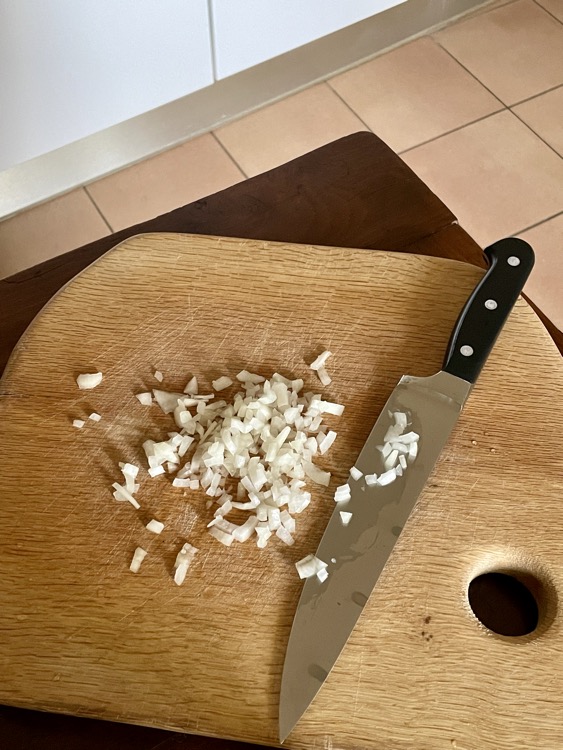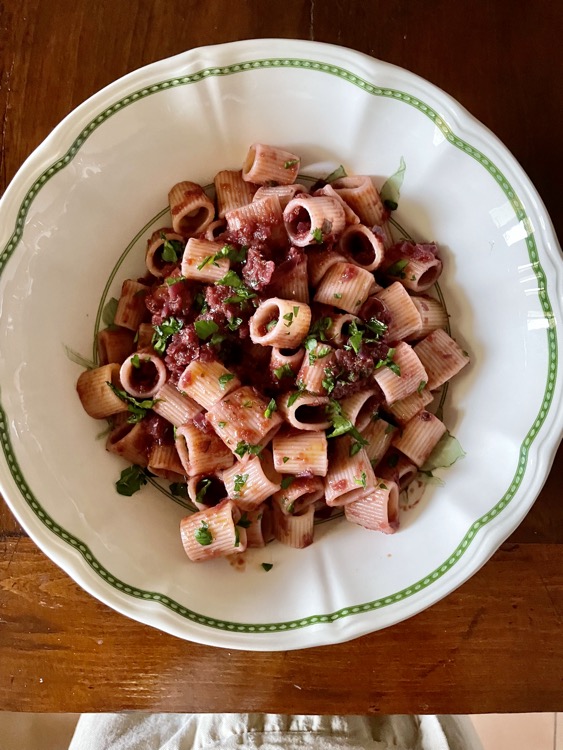I remember.
I am a handful of years old. I’m sitting comfortably in the kitchen chair.
Grandma is cooking while I play.
Of that remote and happy time, I cherish many memories and all of them good ones.
The heritage of the years spent in the kitchen with her and all the other azdore of the home is one I have embraced only in adulthood. Surprisingly, I found that I had assimilated the gestures and cataloged the scents that mark the preparation steps of many recipes.
A discovery I made almost by accident during my years of University when I was far from home. I was hungry and tired of eating sandwiches, so I improvised pasta with eggplant sauce. I had never cooked and yet seemed to know what to do. I wrote about this moment in the post about aubergine balls.

The ragu test
Proceeding by trial and error, I found myself skilled at approaching even complex preparations such as a meat sauce.
I distinguish the first pungent and then balanced smell of vegetables becoming soffritto. The sweet smell of bacon melting, that of tomato sauce softening. Finally, the perfect essence of the ragù when, after hours of subdued muttering, it is ready.
I can attest that I learned how to make ragù, which at home was a la Bolognese before I even cut an onion or discovered that battuto has a soul. Traditional Bolognese ragù represents an indelible olfactory memory I recognize without even peeking into the pot.

Grandma Sara was a cook who could happily alternate between tradition and imaginative innovation. For this reason, I grew up eating pasta seasoned in many different ways.
This workout of the palate has left me with a passion for cooking sauces and ragù for pasta, which I have always associated with the most comforting food the rich gastronomic landscape offers.
As well as it left me with the curiosity to discover new flavors to broaden my culinary perspective.
I am a true ragu recipe hunter.
I develop new recipes, do thematic historical research, and try others’ recipes.
As Ina Garten wrote, comfort foods are often the dishes that transcend cultures and borders.
I completely agree with her. Curiosity leads to unfamiliar flavors or using familiar ingredients differently, enriching the family repertoire with new recipes we will love as if they were ours all along.
I recently tried a red cabbage ragù recipe by Ali Slagle in the New York Times.
After reading the headline, I already felt like cooking.
I love simple recipes like the one I am for sharing; they are the key to surviving even the busiest days drawing comfort from the food I cook and eat.
This colorful vegan recipe is perfect in many ways: it tastes good, allows me to feed even a vegetarian friend, and can be frozen.
The star of this vegetable ragù is red cabbage. But in the notes before the recipe, you will find an alternative if you don’t like it or to change the taste.


Vegetable ragù and the Italian sugo finto or ragù matto
I always have a notebook handy where I have organized the recipes for ragouts and pasta sauces, indicating complexity and preparation/cooking time beside the title.
This way, I don’t give in to the temptation to choose a recipe that doesn’t fit into my work day or week.
I have a real passion for vegetable ragù recipes. On the other hand, one of the sauces I love most for pasta is a sugo finto, a parsley sauce, or, as we used to say in Romagna, a ragù matto, where the flavors evoke that of meat that is not there.
From the peasant tradition, my grandmother inherited several recipes she passed to me. Above all, that of the legume and parsley sauce. Formerly, the second one was made with leftovers from pasta and beans. Then, in the town of Imola, where I was born and raised, the recipe became an original recipe of the zone. Today, among the ingredients, the recipe includes only passata di pomodoro and parsley, without beans.
And, as I just wrote, my favorite.
In the New York Times, Ali Slagle paired ragù with paccheri, a typical Italian short pasta. So I made.
I made a few changes to the original recipe, necessary because of my intolerance to garlic and chili (the latter, also optional in the original recipe). I added soy sauce, which contributes to the full-bodied flavor of this red cabbage ragù: in its simplicity, a little masterpiece.
Buona cucina, Monica
Keep in Touch
- To receive unpublished recipes, tips, and food stories, sign up for the Tortellini&CO newsletter.
- Follow me onInstagram, Pinterest and Facebook.
Reading tip
Ina Garten on the importance of Comfort Food: is an article I recommend to everyone who loves this outstanding food writer and cook.
Recipe notes and a red cabbage alternative
I recommend preparing the different ingredients so you can add them in sequence without stress.
If you prefer a rustic sauce, cook it as I indicate. If, on the other hand, you want a softer consistency, use an immersion blender for one to two minutes after cooking.
The amount of ragù you will get is plentiful. You can store it for a few days in the refrigerator or portion and arrange it in the freezer, ready to use.
Finally, I find it has a versatile flavor, and you can also use this sauce to accompany scrambled eggs or a steak. Advice that the author of the recipe herself also provides.
As an alternative to red cabbage, I recommend using carrots.

Red cabbage ragù
serves 4
List of the Ingredients
half of a small red cabbage
1 small yellow onion
50 g tomato paste
200 ml water
100 ml lukewarm water
soy sauce, 2 tablespoons
sugar, 2 tablespoons
fresh parsley, 2 tablespoons
salt, olive oil and a knob of butter
Method
Wash the cabbage and parsley.
Finely chop the onion, parsley, and cabbage, keeping the ingredients separate.
Melt in a glass the tomato paste in 100 ml of warm water.
In a saucepan, melt the butter with a couple of tablespoons of olive oil.
Gently sauté the onion, add the cabbage, stir, and cook for a few minutes, over low heat, before adding the concentrate diluted in water.
Stir, add the red wine, and let it fade for five minutes over medium-low heat.
Add the sugar, soy sauce, salt, and half the finely chopped parsley, keeping the rest aside for seasoning, and stir.
Add the sugar, soy sauce, salt, and half the finely chopped parsley, keeping the rest aside for seasoning, and stir.
Cook on medium-low flame for about 30-40 minutes. Add water if it seems necessary.
Season the pasta you prefer, preferably short, add fresh parsley, stir, and bring to the table with grated Parmigiano cheese aside.





